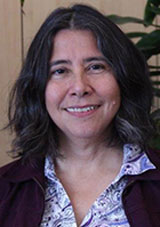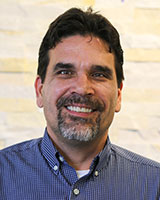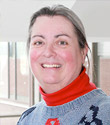Oct 17, 2018
Indigenous People and Domestic Violence: Who's Bringing Solutions
Back to Domestic and Intimate Partner Violence: Some Do's and Don'ts for Health Providers
Bobbi Outten, Director of Family Wellness Warriors Initiative (FWWI) at Alaska's Southcentral Foundation (SCF), said when discussing domestic and intimate partner violence (DV and IPV) in the context of healing communities and individuals, the conversation starts with understanding several important concepts.
Domestic violence happens to all people and it hides — it hides really well.
"Domestic violence happens to all people and it hides — it hides really well," she said. "It's also important to avoid the terms victim and perpetrator – maltreatment is cyclical and often those who harm others were themselves harmed earlier in the cycle. One of our philosophies here at Southcentral Foundation is not to use the words 'victim,' 'perpetrator,' 'abused,' or 'abuser.' Instead we use 'those who have been harmed' and 'those who have caused harm.' We need to eliminate preexisting beliefs that those who harm cannot be restored to a healthy style of relating. Harms experienced and committed must be discussed openly — devoid of guilt, shame, and blame — and men must also be considered part of the solution rather than part of the problem."
Bringing FWWI to SCF's remote and frontier
customer-owners (the term the organization uses instead
of 'patients' or 'clients') starts with relationships,
according to Dr. Donna Galbreath, SCF's Medical Director
of Quality Assurance.

"Relationships are key to our whole system of care," Galbreath said. "We focus on domestic violence prevention all the time to keep it from occurring, but when situations of violence occur, established relationships make interventions more easily implemented."
Galbreath explained that relationship-building starts with an Anchorage-based integrated care team with a physician, nurse case manager, certified medical assistant, behavioral health assistant, and a dietitian. That team also works with a designated pharmacist, scheduler, and an advanced-degree behavioral health professional. This team not only makes routine visits to their customer-owners located in rural communities and remote villages, but remains in continual contact with the teams of nurse practitioners, physician assistants, others permanently staffing those clinics, and community members.
"Through time, our customer-owners come to know their team and their team comes to know them," Galbreath said. "Those relationships allow for honest and open conversations with one another, especially around these violence issues."

Director Outten outlined how the specific customer-owner, relationship-based care, or Nuka System of Care, applies to FWWI, a model used for nearly two decades and found very effective for DV/IPV prevention.
"The rural communities we serve are small, from just a handful of people up to 350 or larger," Outten said. "Everybody knows everybody and many are related — it's basically family. That's important in situations of violence because it affects everybody in the community. Many times a person who has caused harm is very loved, and loved by many who have been harmed. It can be a cycle that in one year, you have been harmed, and the next year, you're the one who's caused harm. We must work with both sides."
Outten explained that bringing FWWI to assist with domestic violence issues in their rural communities starts with a written invitation from tribal leaders. Then implementation begins with developing a community steering committee, chosen to represent all ages and genders. "Natural helpers" are also selected from trusted individuals within a community. For example, grandmothers, maintenance workers, or stay-at-home moms are well-suited to this role and no specific degree or professional experience is required. In addition to natural helpers, designated stakeholders are trained to deliver the FWWI domestic violence program. Outten pointed out the importance of this community-centric approach.
"The communities are selecting the people they want," she said. "We go in and provide the training, but the communities are their own experts and guides. FWWI is a model where the community takes curriculum topics that apply to them, to domestic violence issues, for those who have experienced child sexual abuse, and for those who've experienced trauma. They're trained in 'sharing story' about those topics, like shame, anger, loss of innocence, the loss of safety. They become teachers within their own community and take from the curriculum what they need for their community."
Sharing Story
Because Alaska Native people descend from a long line of storytellers, sharing stories of their personal experiences is a familiar way to learn and understand how specific experiences influence behavior and relationships that in turn impact DV and IPV. The FWWI model has been published and the report includes one family's three-generation story. Now having reached more than 3,500 Native Alaskans, SCF has submitted recent health outcome data for publication. The goal of FWWI? To end domestic abuse in this generation.
"Elders and tribal leaders are always first to share story," Outten said. "They are at the front and give permission and courage to share story. How men and women work alongside each other, willing to talk about the hard stuff."

Robert Heffle, SCF's Learning Circle Clinical Advisor, shared how a medical provider's reaction to hearing that story can impact one who's been harmed.
"When a person discloses their domestic violence experience, the response they receive, the look on somebody's face, the environment, all of those things can make a difference for the person to start building courage," Heffle said. "When people are experiencing domestic violence and it comes to the attention of a provider, the normal way of uncovering history behind other medical problems probably won't stand. You'll need to put the clipboard down, put the checklist aside, and just take a few minutes to enter into that person's space to recognize the courage needed to even start that conversation."
Heffle offered additional advice for providers who become privy to a domestic violence story: Understand that for someone in a DV situation, it can be more dangerous to leave than to stay.
Just having an idea of 'what next' is a start in the direction that's going to make you better prepared when someone discloses.
"If you don't have a behavioral health consultant or somebody that can be on call if something occurs in the middle of the night, work at having alternatives in place," he said, acknowledging every rural community is different. "Just having an idea of 'what next' is a start in the direction that's going to make you better prepared when someone discloses. You have to start with where you're at."

